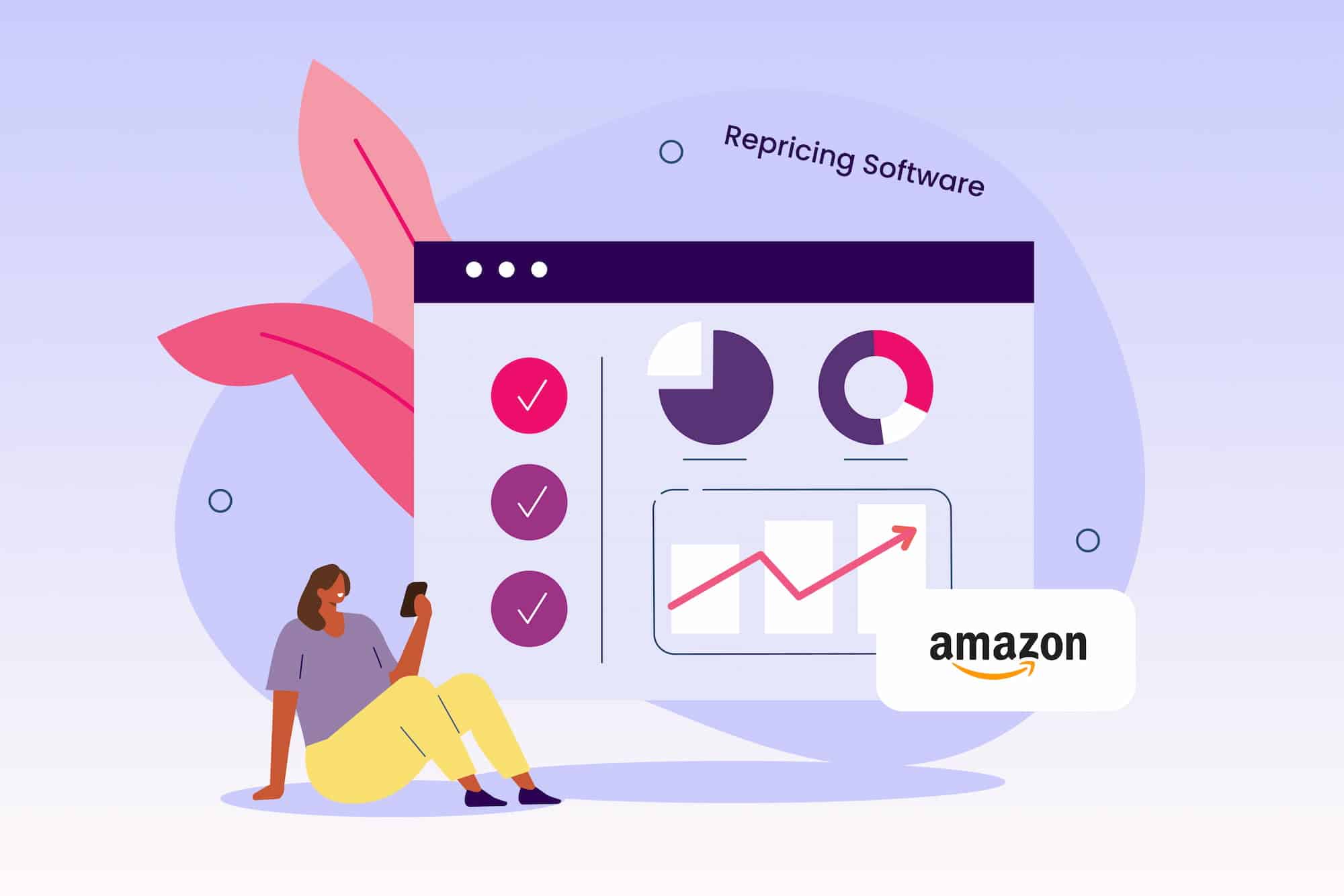As a consumer, what do you look for when you head to Amazon to shop? High-quality products with good reviews tend to be the most important factor, but once you’ve found a few items that fit the bill, your consideration is almost certainly pricing.
No one wants to spend more than they have to—and that’s why a big part of staying competitive on Amazon is related to offering affordable options. While it’s possible to adjust pricing manually as the market changes, this is rarely the most effective strategy. In this post, we’ll explore the nine best Amazon repricing software products to help keep your pricing competitive and give your business an edge.
- Trellis
- Bqool
- Flashpricer
- Zon Repricer
- Seller Snap
- Profasee
- Omniaretail
- Informed.co
8 best Amazon repricing software
1. Trellis
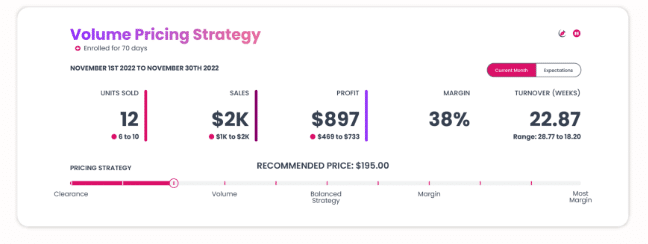
When it comes to repricing, no one does it better than Trellis. Often referred to as dynamic pricing, our AI-driven tool uses algorithms to find optimal pricing as the market changes, activating specific insights to help users get ahead. Dynamic pricing on our platform is centered around a comprehensive three-step process:
- First, pricing algorithms analyze historical data and run tests to determine the market.
- Using artificial intelligence and machine learning, test results are mapped out to suggest an optimal strategy for seller goals, maximizing profit, or supercharging your BSR.
- Once a user chooses a strategy, we’ll do the rest, setting prices daily based on real-time market trends and competitor shifts.
Unlike basic repricing that follows competitors, Trellis goes deeper by connecting your objective with the entire market, ensuring pricing changes are maximizing specific outcomes, not following orders blindly.
Pros
- More sophisticated resources than standard Minimum Advertised Pricing tools alone can offer.
- Run tests for you, providing you with data science experience and daily management out-of-the-box.
- A hands-off approach to implementing valuable pricing strategies.
- A “Goldilocks Pricing” approach that aims to set prices in just the right place, targeting a sweet spot that both maximizes sales and profits.
Cons
- Smaller businesses or those not focused on growth may not need such sophisticated dynamic pricing software.
Key features
- A three-step approach to determining pricing,
- Support from AI and ML for cutting-edge results,
- Automated pricing changes with dynamic strategies in place.
2. Bqool
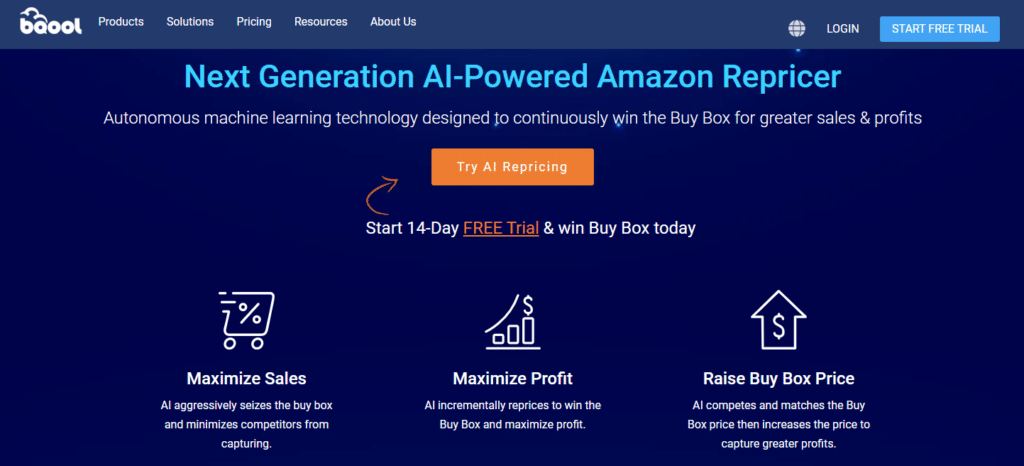
Bqool is all about automation. As an AI-powered repricer that leverages autonomous machine learning, users can confidently make decisions about preferred pricing strategies. This tool focuses on Buy Box wins, yet it can also use factors like overall pricing, shipping attributes, and seller ratings. Those hoping to maximize product margins will appreciate the option to input seller costs to ensure prices don’t dip below a point of profitability.
Users can invest solely in repricing with the Repricing Central tool or take advantage of more comprehensive eCommerce solutions with BigCentral.
Pros
- Set pricing strategies based on seller goals.
- Utilizes five built-in strategies to target unique customer goals.
- 14-day free trial available.
- Schedule repricing based on dayparting.
Cons
- Repricing speed is driven by SKUs in use, not via membership tier.
Key features
- Pricing reporting dashboard,
- Historical pricing records,
- Incorporation of seller costs to set prices.
3. Flashpricer

Flashpricer also excels in Buy Box wins—and allegedly achieves them faster than the rest. Boasting the ability to set pricing before the competition, users can mix and match areas of emphasis with unique and flexible tools to meet specific objectives, even if priorities differ from normal strategies. Better still, Flashpricer relies on real-time data rather than potentially outdated historical trends.
Pros
- Fast price changes.
- Access to flexible, customizable pricing strategies.
- Usage options across Amazon, Walmart, Shopify, and Google.
Cons
- Minimal use of historical trends that may better inform strategies.
Key features
- Free trial with full-service onboarding,
- Flexible and customizable pricing tools,
- Fast, efficient price changes.
4. Zon Repricer
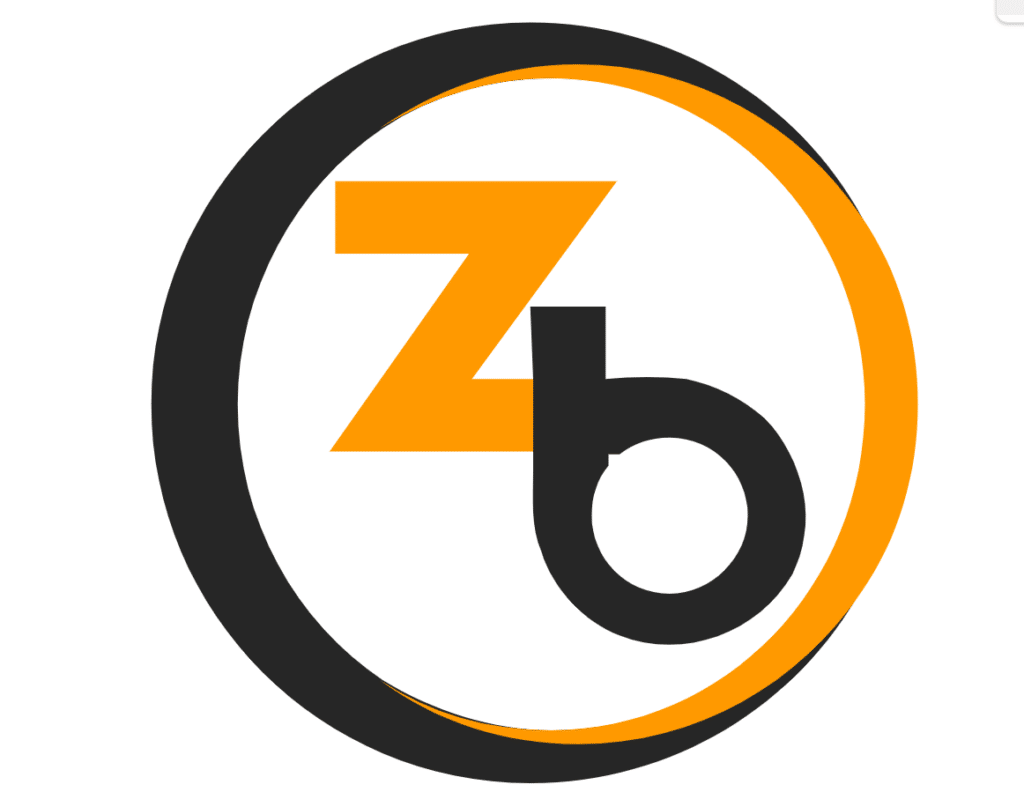
Zon Repricer, a part of the Zonbase environment, is a solid choice for sellers who want to take advantage of repricing without keeping up with analytics and management work. This automated platform is known for swift pricing changes, implementing around-the-clock shifts quickly and effectively. For those worried about profitability, Zon Repricer allows users to input information like product costs and criteria like minimum and maximum pricing to ensure optimal pricing doesn’t interfere with driving revenue.
Pros
- Customer support from Amazon seller experts.
- Hands-off management approach.
- Takes into account profitability goals.
Cons
- Additional fees for some additional functions on top of subscription costs.
Key features
- Fast pricing changes,
- Automated repricing based on goals,
- Clean, simple interface.
5. Seller Snap
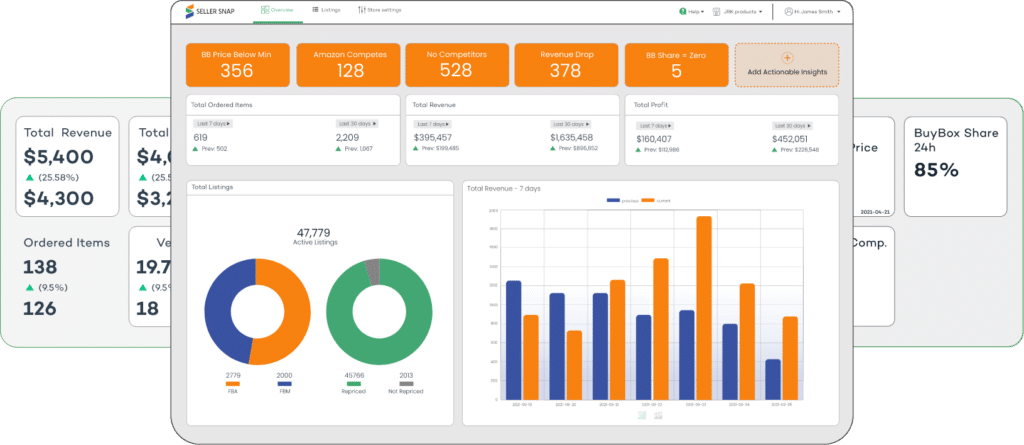
A hands-off solution for those who want to focus on their core business objectives, Seller Snap claims to save users an average of 60 hours a week. This AI-driven tool can provide many options for users, including setting business discounts and basing pricing on factors like Buy Box wins, the number of competitors in the market, and average prices. In addition to helping set competitive pricing via a Game Theory-based model, users also have access to a dashboard of reporting metrics, helping to track things like historical pricing and the most effective pricing models. And, for those who sell internationally, Seller Snap can be used across 18 different Amazon marketplaces.
Pros
- Game Theory-based repricing strategy.
- Saves up to 60 hours a week.
- Set prices based on the optimal strategy for your objectives.
Cons
- Steep pricing for relatively basic abilities.
- No real-time data on sales made.
Key features
- Fully automated repricing abilities,
- Numerous pricing strategies,
- Dashboard for reporting metrics.
6. Profasee
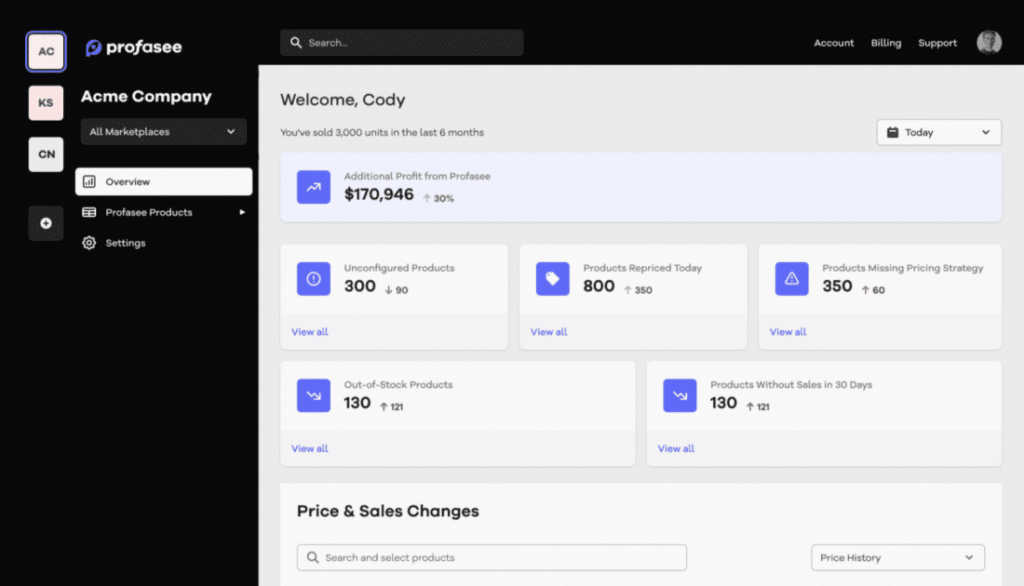
With an emphasis on dynamic pricing strategies, Profasee insists it can “see into the future.” The tool is able to analyze over a billion points of data based on shopping trends, leveraging machine learning, statistical models, and economics based on buyer behavior to set and adjust prices quickly. The platform considers multiple other factors, including dayparting, seller pricing minimums and maximums, perceived demand, and Amazon rankings.
Pros
- Intuitive and easy-to-use software.
- High levels of accuracy in price setting.
- Service across many international Amazon marketplaces.
Cons
- The dashboard is rather limited.
Key features
- Pricing predictions,
- In-depth data analysis,
- Dynamic pricing.
7. Omniaretail
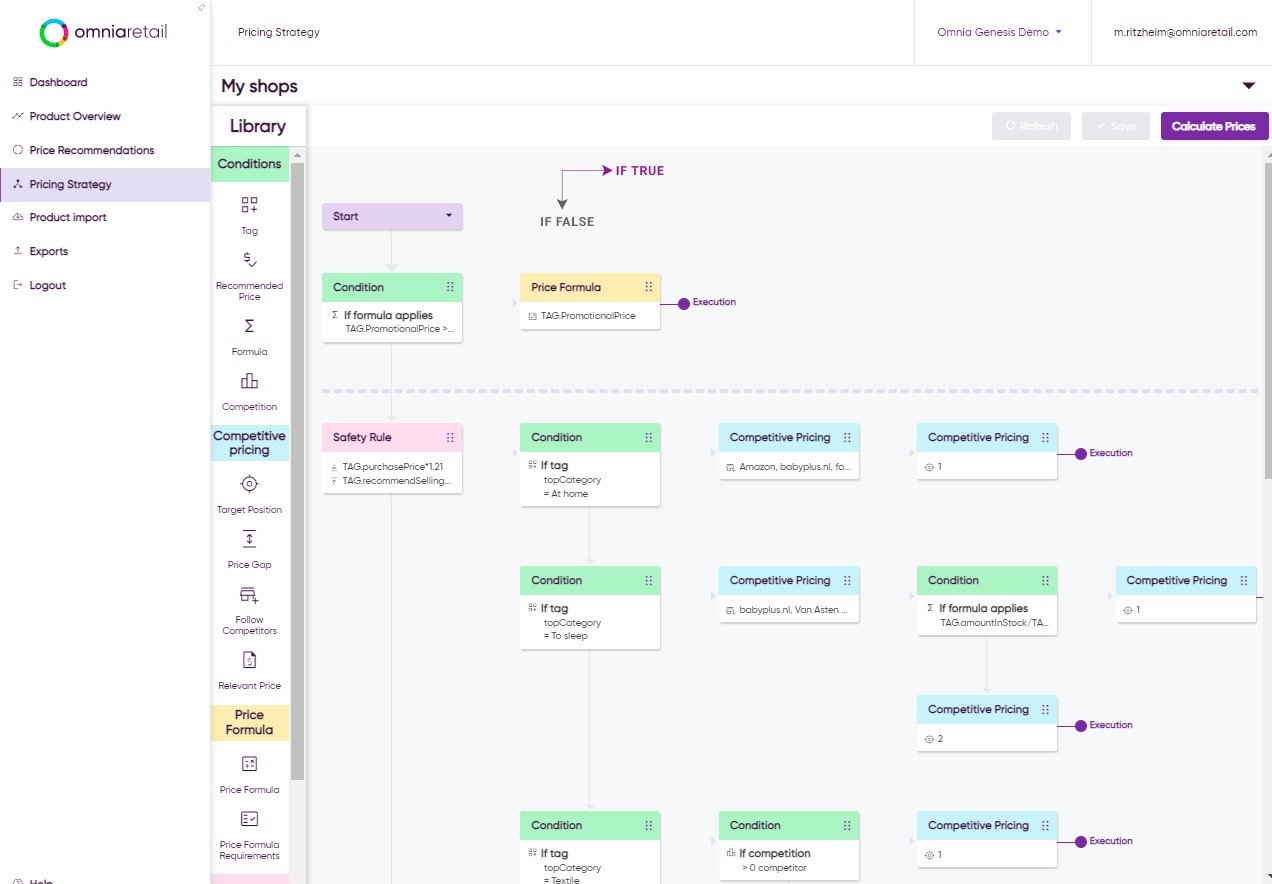
Omniaretail is an advanced, comprehensive tool with a focus on dynamic pricing. Offering a unique Pricing Strategy Tree functionality, users can adjust, configure, and examine every facet of data-driven pricing. All information used to inform tactics is scraped from numerous marketplaces, competitor pricing, and comparison shopping engines, ensuring a robust pool of information to draw from. Pricing rules are also very transparent; each area of emphasis comes with a “Show Me Why” box that explains how criteria are set and how resources collaborate for the best results.
Pros
- Transparent and flexible approach to dynamic pricing.
- Unique Pricing Strategy Tree and “Show Me Why” box for a thorough education.
- Ability to change pricing multiple times per day.
Cons
- Focused on European marketplaces, limiting North American seller usage.
- A weighty system that is generally only warranted for enterprise-sized merchandising teams.
Key features
- Dynamic pricing,
- Advanced data scraping,
- Pricing Strategy Tree functionality.
8. Informed.co
Informed.co provides quick, easy access to Amazon repricing based on user goals. Do you want to get the Buy Box? Compete with the lowest pricing? Rival the top merchants? Not a problem—you can choose what strategy means the most to you at any given time and get results that are best aligned with those objectives.
AI-driven algorithms work around the clock to keep your products priced appropriately. Users can even choose the extent of AI support in use; businesses who want to be in full control can customize the approach for every product, while those not interested in being overly involved can let the Informed.co repricer do all the work.
Pros
- Flexible AI support based on customer preference.
- Option to target specific pricing goals.
- Around-the-clock pricing changes that move with the market.
Cons
- Costs are based on the scale of business, not membership tier.
Key features
- Automated pricing based on AI,
- Profit Protection,
- Use of historical pricing data to guide strategy.
Considerations when choosing a repricing software
Repricing software is a must when hoping to stay competitive in eCommerce marketplaces. Your competitor’s strategy for pricing has an impact on your brand whether you want it to or not, so investing in the right software can ensure you leave no stone unturned in an effort to keep up. Here are some considerations to keep in mind when choosing the best Amazon repricing software for your business and needs:
Involvement and experience needed
Every best Amazon repricer option uses varying tools and approaches, so it’s critical to understand the differences and pros and cons before picking your top choice. For example, do you want a tool that’s more set-it-and-forget-it or one that allows sellers to be hands-on? Also, consider whether you’d prefer to rely on simple repricing strategies to ensure the lowest price possible or put your trust in more robust and dynamic tools.
Speed
Not all repricers can achieve pricing changes at the same speed. If you’re in a competitive niche and looking to lap other brands, this is an essential point to keep in mind. Alternately, you may favor a slower yet more targeted approach, relying on daily changes rather than a more rapid, flip-flopping strategy that could be challenging for you to monitor.
Buy Box friendly
For some sellers, winning the Buy Box is of the utmost importance. While many repricing tools have the ability to focus on Buy Box placement, a software that is more tailored to this goal may be a better choice than one with more diversified options.
Repricers vs. dynamic pricing vs. rule-based pricing
There are multiple ways that optimal pricing can be achieved. The three major models used to determine just the right number are repricers, rule-based pricing, and dynamic pricing.
Repricers
Basic repricers work to change prices in accordance with simple needs. Users may set a standard goal, like the lowest prices possible or maximizing Buy Box wins. These are easy, straightforward tools that respond to linear goals.
When you should use a repricer
Many repricers take limited forms, like Minimum Advertised Pricing. This can be a good option for small sellers without a budget for more advanced Amazon repricer tools or for brands wanting to maintain a slight competitive edge in a limited space.
Dynamic pricing
Also called algorithmic repricing, dynamic repricing is an automated solution based on AI and machine learning. It takes standard rule-based pricing and goes deeper by taking into account a wealth of seller information.
Dynamic pricing aims to find an optimal price point rather than shifting with the market based on set rules. While often less flexible than repricers that go by parameters alone, dynamic pricing often yields the best overall results.
When you should use dynamic pricing
Dynamic pricing is the most sophisticated and targeted repricing option and, thus, best for advanced sellers, including those with large catalogs and selling in competitive categories.
Rule-based pricing
As the name indicates, rule-based pricing is managed by a set of criteria, either set via AI or seller-created parameters, that guide when and how pricing should be adjusted. This may be simple, like dropping prices to contend for the Buy Box position, or more sophisticated, like tracking trends and dayparting.
When you should use rule-based pricing
Rules-based pricing is best for sellers who want to operate repricing objectives based on a set of strict parameters rather than one targeted goal or more comprehensive dynamic pricing. This may be the best solution for a business that doesn’t require the depth of dynamic pricing but still wants to be able to set repricing goals based on flexible goals.
How do Amazon repricers work?
How Amazon repricer tools work really depends on the model of repricing in use. Simple repricing platforms use specific criteria, like ensuring the lowest possible list price, while others rely on a set of rules, which can be flexible or AI-driven. Dynamic pricing, and to a minor extent, rule-based pricing, leverages AI and ML tools to dig deep into sales objectives to come up with a custom-curated approach designed to maximize revenue and optimize seller strategies.
Why Amazon sellers need repricing software
Simply put, repricing software is a must for sellers looking to get ahead in eCommerce marketplaces. This is mainly because most other sellers will have these tools in place, too. So, to stay competitive, you’ll need to employ a third-party solution or watch Amazon like a hawk and manually adjust prices.
What’s the ROI when using a repricer?
The ROI of Amazon repricing software will depend on many factors, such as:
- The number of SKUs in use,
- The kind of repricing tool employed, and
- The business goals of using a repricer.
While some sellers can justify the higher price point of a dynamic pricing tool, others can’t; in turn, basic repricing tools might be enough for small-scale sellers but would cause high-volume businesses to lose significant ground. To maximize ROI, determine the features most important to your sales strategy, calculate your budget, and invest in the highest caliber tool possible that won’t stretch sales margins.
If you want to maximize what repricing software can do for your business, Trellis can do wonders for growth and profitability. Let us show you the way—schedule a free demo today.



